|
VE3OIJ Peter D. 'Darin' Cowan Ottawa, ON Canada QCWA # 37627 Chapter 70 |
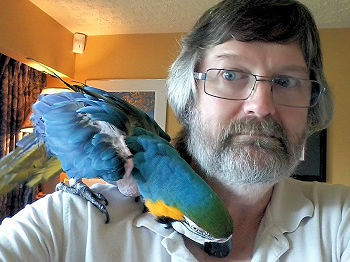 |
Please excuse this wall of text, but as anyone who has done PSK with me can attest, I'm long-winded :) All the info you ever wanted to know about VE3OIJ is here.
I first found an interest in radio in 1975, when my parents and a number of their friends had CB radios. I got my first multi-channel CB hand-held two years later and set about building antennae to improve its range. In high school in 1981, I had access to the electronics lab, and some nice receivers. I learned morse code and took up the hobby of Short Wave Listening. I experimented building my own short wave receivers. That year I also acquired a new multi-channel, high power (5W) CB hand-held to chat with my other radio friends.
I joined the military (Communications Branch) in 1983, and oddly enough, had essentially zero opportunity to work radio until I left in 1992, although I did get to play with some radar in that time. I have been asked many times how it is that I was in the communications branch of the air force and hardly got to work any radio. The answer is simple, but people never think of it: I was an officer, and I went through the military college system (Royal Roads Military College) to get there. I didn't have to operate the radios or send morse code except in very, very unusual situations - situations which never occurred in the case of morse code. If I needed a message sent, I'd write it down and give it to one of the highly skilled operators working for me. I wasn't even trained on morse code, although I was trained on operating most of the radios I was likely to encounter. It simply wasn't my job to operate radios and send code.
Shortly after I left the military, some friends had decided to get their amateur radio licences. I was volunteered to drive them to the exam site, and when I was there it was suggested that I should write as well. It was pointed out that even though I had not prepped for an exam, failing the exam had no obvious downside. The examiner also noted that he had an extra exam, and also invited me to take a stab at it. So I wrote, and passed!
Thus licenced in 1992, I would, over the course of the next year pass my morse code and Advanced qualifications. I was active until late 1996, when I took a hiatus from amateur radio until 2006. I am up and running again, usually with my Yaesu FT-847 at home. Currently interested in PSK and SSTV, although I am often on other digital modes, and even phone and CW from time to time. I also have a totally portable all-band/all-mode station based around a Yaesu FT-897 that I take to the cottage and to special events.
A note about CB radio: There are many cranky old curmudgeons in amateur radio who like to drone on about the evils of CB, or how ham radio is becoming like CB or how they had to do morse code at 90 below zero uphill in both directions back in their day. These individuals don't realize that if it wasn't for CB sparking interest, a lot of people wouldn't be hams today, and that means that CB is saving this hobby. If these self-appointed expert radio amateurs spent half the time mentoring new hams as they do complaining that things have actually progressed since the 1960s, we would all be much better off. It's CB that got me interested in radio, and I'm proud of that.
CB is still more useful than amateur radio in some situations. Don't underestimate the value of CB for getting info on the traffic ahead of you on the highway, for example. Folks on your local repeater (at least in the places I travel) seldom seem to have this information handy. Sure, CBers are sometimes kind of base or immature on the radio, but have you ever taken an objective listen to some of that 80m and 40m sideband chatter coming out of the USA for as long as I've been listening to radio (i.e. well over 30 years)? "Kettle, thy countenance is dark," said the Pot.
Bands and Equipment
Home:
At home I use a Yaesu FT-847 for 80m to 70 cm, and an Alinco DR-235 for 1.25m, and an Icom ID-1 for 23 cm. My antennas are a Butternut HF9V for 80m to 6m, a Comet CX-333 for 2m / 1.25m / 70 cm, and a soon-to-be-deployed 19 element home-brewed yagi for 23 cm. I have a RM Italy 300W amplifier which I rarely use.
For digital work, I have a Kantronics KPC3+ (APRS) and a RigExpert Plus.
Mobile:
In my car I have a Kenwood D-710 (2m / 70 cm), and an Alinco DR-235 (1.25m) running into a Comet SBB-224 tri-bander. For APRS, I plug in my Garmin 76CS GPSr.
Portable:
I also maintain a totally portable station for use at events, camping, wherever. This station has a Yaesu FT-897D (with batteries), Kenwood D-700, RigExpert Tiny (although I often take the Plus from my home when I go portable). It is powered off its internal batteries, car batteries with an inverter, or a Honda 2000i generator. Antennas are HyGain DP-19D spooled dipole, and a Buddipole in dipole configuration. Since it's portable, my mobile equipment is also available wherever this is, so the portable station is QRV from 80m to 70 cm.
Club numbers
PODXS 070: #536
DMC: #425
30MDG: #419
EPC: #4114
FH: #1472
NDG: #304
WCC #055
Ottawa Valley Mobile Radio Club
VE3JW Exhibit Operator at the Canada Science and Technology Museum
QSL Info
I avidly collect QSL cards! I QSL the first contact for all HF, satellite, and 6m contacts. VHF and UHF contacts made direct (without a repeater or internet assistance) will also be QSLd. I send out summary cards on occasion, if we have a lot of contacts, in particular if you work me on 5 bands. I love to receive regular, old-fashioned QSL cards, and think that QSLing is an important part of the hobby. Most cards I send go by the bureau, but if I notice that you have other instructions, I try as best I can to follow them.
I use eQSL (AG) primarily as a log backup, and also send cards via the bureau. I do not use LotW, and will not be moving to LotW any time soon. If you really must know why, shoot me an email and I will detail the reasons. People wishing to use contacts with me for ARRL awards will have to do it with old-fashioned, paper cards (or you could pester ARRL to accept eQSL). Please note that even if you say "No eQSL", I still upload my logs to eQSL. The reasons for this should be relatively obvious, but if you don't know, it's because my software does the upload automatically. If you don't use eQSL, that's fine by me, and if you change your mind in the future, the eQSLs will be there.
You are welcome to QSL direct to me. I would appreciate it if you could include return postage and a self-addressed envelope because that is what I send when I QSL direct, but I'm not going to freak out if you don't... At the end of the day if you're sending me a card, and I send you a card we're pretty much even as I see it. I will respond to direct QSLs directly, and to bureau QSLs via the bureau (except for special event QSLs, which must include return postage for a direct response - see below).
Return postage (as of March 2010) is this:
You are in Canada (or Canadian military): a $0.57 CDN stamp
You are in the USA (or US military services): $1 US, or $1 CDN coin, or an $1.00 CDN stamp or an IRC. An IRC is overkill, but it will work.
You are in any other country: $2.00 US, or $2.00 CDN, or a $1.70 CDN stamp (not a US or other country stamp), or an IRC.
QSL for VE3EEE, VA3PDC, VE3PDC, CG3OIJ, CK3OIJ, VE3MOON
I operate a second callsign on occasion: VE3EEE (effective 23 March 2010). QSLs for that callsign can be sent to me at the above address. I have a separate AG eQSL account for the additional callsigns. Cards sent via the bureau should be sent with VE3OIJ as the QSL manager:
1 June 1993 - 31 December 1996: I operated a second callsign (VA3PDC). I believe all cards I have sent out for this callsign have been responded to. However, if you have a QSO with VA3PDC during these dates, please send the card direct with return postage. Do not send to the bureau as it will likely confuse them as this call has been reissued.
Dec 2006 - Jan 2007: Industry Canada authorized the use of the CG prefix for Canadian amateurs in celebration of the 100th anniversary of the Reginald Fessenden transmission. I contacted about 200 stations. QSL cards have been sent to all stations - either directly if I received a direct QSL, or by bureau. (CG3OIJ)
Oct 2008 - Nov 2008: Industry Canada authorized the use of the CK prefix for Canadian amateurs in celebration of the 150th anniversary of the founding of British Columbia. (CK3OIJ)
Jan 2009 - Feb 2009: Industry Canada authorized the use of the CG prefix for Canadian amateurs in celebration of the International Year of Astronomy. (CG3OIJ)
14-27 July 2009: Industry Canada authorized the use of the special callsign VE3MOON. This callsign will be used by a special event station celebrating the 40th anniversary of the first landing of humans on the moon. (VE3MOON). Only one paper card will be issued per callsign. Please note: Cards sent direct for this special event, but without return postage will be returned via the bureau. Return postage is listed above.
15 June 2006 - 23 March 2010: I operated a second callsign (VE3PDC). I believe all cards I have sent out for this callsign have been responded to. However, if you have a QSO with VE3PDC during these dates, please send the card direct with return postage. Do not send to the bureau as it will likely confuse them as this call has been reissued.
Contest Successes
PODXS 070 Club: 40m Firecracker Sprint 2007 - Top Score
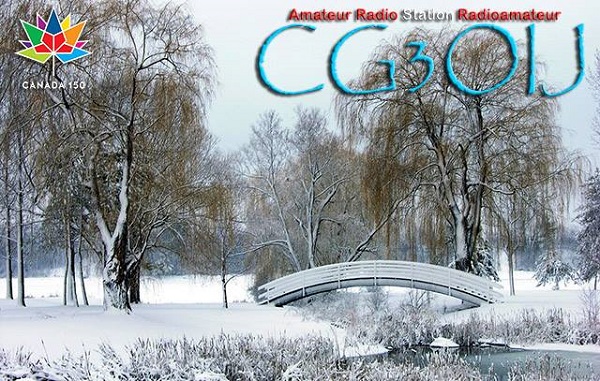
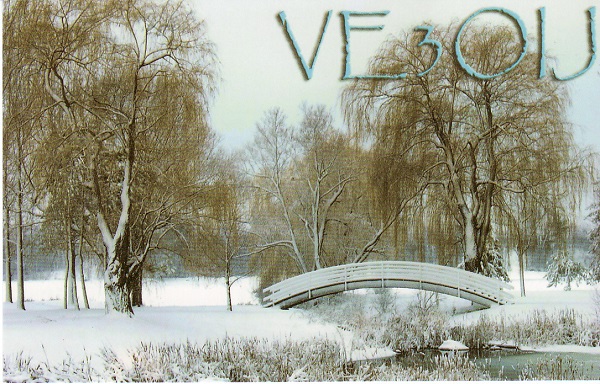
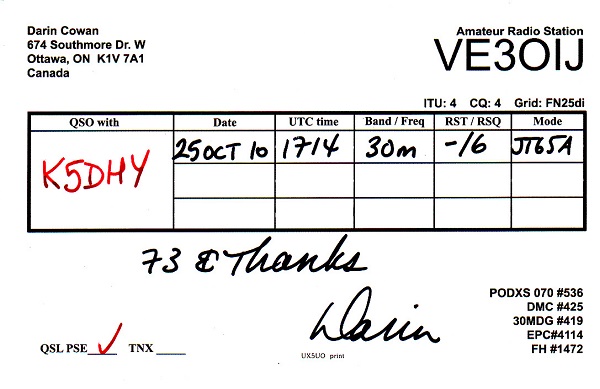
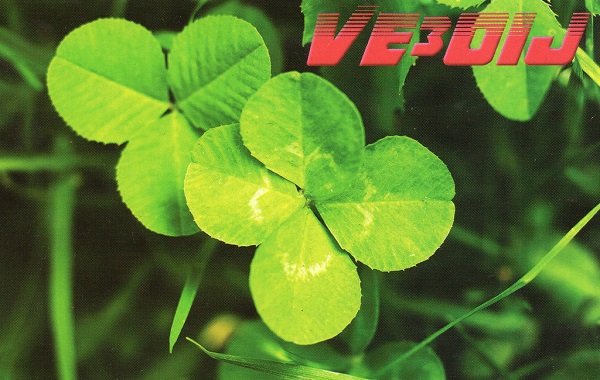
February 19, 2018